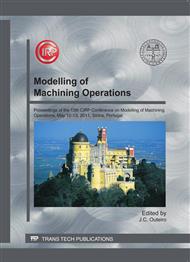p.622
p.632
p.642
p.652
p.662
p.671
p.679
p.691
p.701
FEA-Methodology for the Prediction of Aluminium Thin Walled Part Deformation in Dry Milling Operations
Abstract:
The presented work is a part of the EU integrated and collaborative project “Aligning, Holding and Fixing Flexible and Difficult to Handle Components” (AFFIX). The deformation of thin-walled components, caused by a thermo-mechanical load in the machining process, is a common challenge in manufacturing automotive engine heads and gearboxes. Geometrical tolerances like flatness are strongly affected by the thermo-mechanical process loads, and therefore cause production scraps and serious engine faults in case of undetected defects. To avoid long process setup times, a methodology has been developed to calculate the resulting part flatness. Based on the developed methodology a clamping strategy has been identified which minimises the resulting part deformation in milling operations and thus ensures the accuracy and quality of thin-walled aluminum power train parts.
Info:
Periodical:
Pages:
662-670
Citation:
Online since:
April 2011
Keywords:
Price:
Сopyright:
© 2011 Trans Tech Publications Ltd. All Rights Reserved
Share:
Citation:


